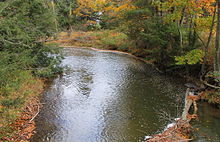Catawissa Creek
| Catawissa Creek | |
|---|---|

The creek near Brandonville, Pennsylvania
|
|
| Etymology | Corruption of the Algonquin word Gattawisi, meaning "Growing fat" |
| Basin features | |
| Main source | Southwestern Luzerne County, Pennsylvania |
| River mouth | Susquehanna River |
| Basin size | 153 sq mi (400 km2) |
| Tributaries | |
| Physical characteristics | |
| Length | 41.8 mi (67.3 km) |
Catawissa Creek (colloquially known as The Cat) is a 41.8-mile-long (67.3 km)tributary of the Susquehanna River in east-central Pennsylvania in the United States. Its watershed has an area of 153 square miles (400 km2).
The waters of Catawissa Creek are highly acidic, with a pH of 4.5, due to runoff from an abandoned mine in the creek's watershed. Catawissa Creek is smaller than the nearby Fishing Creek due to a lack of major tributaries.
Catawissa Creek starts in Luzerne County, not far from Hazleton. It flows west and slightly south into Schuylkill County before flowing north into Columbia County and then west to the Susquehanna River, which it flows into at Catawissa. It parallels Catawissa Mountain for a significant portion of its course.
The surface rock in Catawissa Creek largely consists of sedimentary rock, such as sandstone and shale. However, there is also coal in the watershed. Major soils in the creek's watershed include the Leck Kill soil and the Albrights series. Most of the steeper hills in the watershed are situated near the headwaters of the creek.
Coal mining was once a major industry in the Catawissa Creek watershed, but this is no longer the case. Major tributaries of Catawissa Creek include Little Catawissa Creek and Tomhicken Creek. The president of the Catawissa Creek Watershed Restoration Association, Ed Wytovich, called Catawissa Creek "probably the most beautiful screwed-up stream east of the Mississippi".
Where the Audenried Tunnel meets Catawissa Creek, the concentration of iron is 0.7 milligrams per liter (mg/L). The daily load of iron is 71.3 pounds (32.3 kg), which is 1.24 times the total maximum daily load allowed under the U.S. Clean Water Act. There are 2.28 mg/L of magnesium in the creek. The daily load of it is 232.4 lb (105.4 kg) per day, which is 3.73 times the total maximum daily load. Aluminium makes up 7.93 mg/L. The daily load is 808.2 lb (366.6 kg) per day, which is 19.8 times the total maximum daily load. The total concentration of acidity in the creek is 68.08 mg/L. A total of 6,938.4 lb (3,147.2 kg) flow through the creek. This figure is 100 times the total maximum daily load. The concentration of alkalinity is 2.31 mg/L, which equates to 235.4 lb (106.8 kg) per day.
...
Wikipedia
